17th International Conference on Making Cities
Livable
Freiburb-im-Breisgau, Germany, Sept. 5-9 1995
Prof. Celestino Soddu
Arch. Enrica Colabella
Title:
Recreating the city's identity with a morphogenetic urban design.
Abstract
The increasing complexity of the urban environment requires that we
control and plan the development of any given town without homogenising
its internal differences and the peculiarity of its identity. To achieve
that, we have designed a software program based on Artificial Intelligence,
capable of controlling the development of the image of the environment
as a dynamic mathematical system. This tool enables us to design the morphogenetic
code, the DNA of the environment, and, modifying this code and simulating
the incoming possible scenarios, we can directly plan the development of
the environmental system. This design procedure is obtained by generating
a sequence of multiple, completely different, spatially formalised scenarios.
Each scenario is characterised by a different virtual development history,
yet they all share the same logical approach, the same DNA. The challenge
is to design the development of a town by modifying and enriching its peculiar
development code rather than merely one of its possible scenarios. Thus
we can increase the complexity of a town environment, while at the same
time strengthening its particular identity. The case study presented here
concerns the evolution of a part of the historical centre of Rome. We have
realised this project through the simulation of different possible scenarios.
The morphogenetic code that we have used follows our subjective interpretation
of the DNA of Rome and of its complexity.
Introduction.
Making cities livable. The city must answer, in a germane way, to the
increasing requests and needs of its inhabitants, but above all to the
unpredictable subjective needs of each individual, who "lives" the city
following his own thoughts and his own desires and his own conceptual paths.
The fields of relevance of these requests are manifold: from the contradictory
requests concerning artificial and natural ware, to the needs concerning
the recognisability and the preservation of difference; from the needs
concerning the adequacy, in real time, of the evolution of human life,
to the need to find in our cities the patina of time that tell us we are
alive.
But all these needs are not so easily classifiable in optimised data
that are legitimate for all. Each of us is unique and unrepeteable, and
our needs are, above all, subjective needs. The city, to be a livable one,
must know how to respond to the unpredictable subjective requests of each
of its citizens.
The city must be adaptable to the multiplicity of subjectivities, but
the same time must be recognisable, unique and, more, it must preserve
its identity.
A precise relationship exists among the subjectivity of needs and the
identity of place. Everyone gets the answer to his main need which is to
live in an environment that respects the uniqueness of the individual.
This is possible only in a city in which the identity, difference and oneness
of the same environment has been saved. An environment homogenised with
an approach that follows only optimisation standards gives birth to a want
of response in our subjective search of the happiness, and of the sense
of our presence and existence.
But what does the "identity" of a city means, and how is it possible
to save this identity from destruction, from the homologation of the image
and from the levelling of the performances?
We can follow two different paths, that depart from different and contradictory
presuppositions. A way is to save the existing events by freezing them,
because we read the identity of an environment as belonging to a particular
static equilibrium. But this approach run the risk of transforming each
city into a museum and could not be an approach that brings us very far
if applied to the entire city and not only to some exceptional existing
events. The city, considered as a structure which identity is part of its
contingent equilibrium, doesn't evolve and die, totally losing its identity
as a living environment.
The other approach, even if it is more difficult to manage, sees the
identity of an environment in developmental procedures, in the modes, consolidated
by the time, of controlling the increase of complexity, and that represents
the culturally unique and unrepeateble matrix of the site. Like an olive
tree that, overworked from the wind and from the rain becomes more and
more an olive tree. It enhances its own identity, while, if grown protected
in a bell of glass loses its own identity because it has not the occasion
to explicate and represent its character. Following the same way, each
city explicates its own identity living the perpetual shifts of cultural
moments and unpredictables events, living and using the occasions created
by the increasing of complexity of the life of the man, and of his needs,
but also created by the chancing of each subjective approach.
This way is, however, much more complex than the first, and more difficult.
The structure of our approach.
The hypothesis that we present in this paper is our response to a challenge:
to design and check the identity of a specific urban environment identifying
and using the developmental code of that city. This means that we can abandon,
if not in exceptional cases, the control of the evolution using the operations
of interdiction, that are now the rules that brake the increase of complexity
of the cities. The objective is to operate by looking at the possible,
identifying the fields of evolution, building the codes that will enhance
the city's identity. This tool should operate without using the creation
of cages, but with the custom of design modes that guarantees the quality
of that is proposed through the relevance to the cultural approach that
identifies the genius loci, even if the design proposal is new, unpredictable
and subject to the cultural identity of the designer.
These modes could be explicated and incorporated into design processes
if they become morphogenetical codes, an operative DNA of the city realised
like a control software that regulates the modes of increasing complexity
of the environment.
Because the real problem is the management of this complexity. The
complexity derives from the evolution, from having crossed an "history"
that has enchanted the identity of the system. Most of the time, the credibility
and recognisability of an urban environment is removed by simplification.
And the typological optimisation it is a simplification. The complexity
involves the adaptivity to each possible consumer, the progressional stratification
of significant structures that, reacting with the subjectivity of each
individual, shows unexpected performances, but relevant in front of the
needs. And these answers, unexpected and subjective answers, can make our
cities livable.
The projects we have done are structured and represented as Morphogenetical
Codes of specific towns or of a species of town, like Medieval Towns in
Italy, or towns with a waterfront like Montecarlo, and so on. These projects
can generate an unpredictable sequence of incoming virtual scenarios that
represent the "idea", the identity of these cities, and allows us to control
this identity in managing, following and increasing this unique identity,
the evolution of these environments.
Structure of the town design based on the
Morphogenetical Code.
We have developed a design tool which offers the possibility of computer
simulation of the formal dynamics of a town system, identifying its particularities
starting from the instability of the system and simulating the transformations
of urban shape through time.
This original software is designed to produce computerised three-dimensional
models of possible urban patterns. These models, although they are produced
with the same series of algorithms, are always different and unpredictable.
The capacity for irreversible events to modify the structure of urban
growth systems is represented by the plurality of formal potentials, of
scenarios that the system can produce.
The software tool we have developed is therefore an instrument capable
of generating dynamic sequences of urban shapes through time. It offers
an almost infinite variety of possible shapes, thus realising a pertinent
representation. The objective is, in fact, to illustrate the dynamics of
development of urban shapes, not to concentrate on one single ephemeral
moment of equilibrium.
The incoming urban scenarios are obtained from the previous scenario
using a time simulation, with the artificial life of a virtual history.
So, let us first analyse this process, in its overall structure, and then,
step by step.
The scenarios we use to initiate the virtual evolution are not a representation
of moments of equilibrium of the system but of moments of disequilibrium.
We read the city as a dynamic system in dynamic evolution.
What does this assumption mean for the urban system we want to represent?
The algorithms we have used for the initial urban scenario are not only
different and autonomous, but can also be contradictory. And not only each
single algorithm but also the series of algorithms, that are not reciprocally
integrable. For example, the series representing the logic of urban growth
can contradict the series for architectural formalisation.
The simultaneous or cyclical utilisation of these series (whose tends
toward disequilibrium) gives rise to the virtual beginning of time.
Each new architectural form modifies the urban shape, each new urban
development influences the style to come, contributing irreversibly to
a town's history.
Although the process occurs within the same logic, each simulation
starting from a scenario produces different possible incoming scenarios.
The fact that each scenario derives from the previous one renders all incoming
scenarios recognisable as "species", and the urban image produced is always
recognisable as belonging to a particular town. We can work with the identity
of each town, with its uniqueness.
Let's look, in more detail, how morphogenical simulation is carried
on with the passage of time in the history of a town. To simulate the passage
of time, it is necessary to define an initial situation of disequilibrium
when initiating a series of transformations. The initial situation of disequilibrium
is determined through a series of disconnected algorithms representing
different development sequences, often contradictory but that must operate
simultaneously. The increasing complexity in the tracing of urban shape
simulates the series of irreversible events in the history of a town.
Let's follow this cycle starting from any point - for example a new
architectural form:
1. The urban context generated until this moment is compared with a
series of algorithms in progress operating to represent the possible/desired
delineation of a new level of complexity.
2. The result is a series of growth requests corresponding to the expectations
of incoming scenarios with respect to the previous one.
3. These growth requests are directed to a series of algorithms representing
one of the logical pathways adopted for the formalisation of the architectural
object. The program is designed to make an evaluation of functional interstices
and margins of feasibility within the framework. These margins are defined
as design opportunities to increase shape complexity that goes beyond the
programme requests. The formalisation is made by the software not using
a data base of elements, because this kind of answer is predictable, and
thus, not suitable for dynamic processes. The process occurs activating
simultaneously many different devices (formal, geometrical, dimensional,
integrators of complexity, etc.) that are autonomous, not necessarily congruent.
The unpredictability of the outcoming scenario is due to the use of resonances
between the linear flowing of each device's activity. This resonance generates
a non-linear output.
4. The result of this operation is an architectural event more or less
exceptional, depending on the randomness of the generating instruments.
This event is then compared with requests and its acceptability is evaluated
"a posteriori". If the event is normal, it is accepted and if it is exceptional
it can be accepted or not according to the availability to the exceptions
registered in the program/morphogenetical code. If it is not accepted,
we go back to point 3.
5. The event is inserted in the context. The scenario increase its
complexity. The event becomes irreversible. In fact, even if it is eliminated
afterwards, the fact that it has existed has conditioned the urban shape
evolution. 6. The code used till this moment must be adjusted after this
irreversible modification. It can be a matter of simple adjustment if the
architectural event is to be considered normal; however, in the case of
an exceptional event it may be necessary to modify substantially some proposals
of the code: This requires the passage from one form to another one and
can be represented using Rene' Thom's catastrophe theory, regarding discontinuous
changing processes. This variation can be described as the passage from
one attractor to another, recognising the attractor as a model capable
of representing the formal characteristics of an event in a dynamic sequence.
7. The new context is then used starting again from point 1 and continuing
until time has been entirely simulated and the initial shape transformed
into that of the possible incoming one.
Case Study: Rome
The identity and uniqueness of Rome is due to its specific way of living
history, time, contingent events. An operational hypothesis to design a
subsequent growth of this city must be based on the identification of a
developmental code that reflects the developmental tendencies, the modus
operandi of this city, the DNA of Rome.
Our design is the proposal of a morphogenetical code that represent
Rome and his developmental way. In operational terms, this project is a
metaproject/software realised to be a tool to hypothesise and generate
a set of possible incoming scenarios. These scenarios must have, in their
difference and unpredictability, the character and the identity of the
Roman urban environment.
This design approach doesn't operate on the city as a static system,
but directly on the urban dynamic system that, in the meantime, is evolving,
describing the manifoldness of its possible evolutions in real time.
Our designing idea identifies a possible developmental code able to
simulate the modes that characterise the evolution of Rome. This code is
based on considerations extracted from an imaginary of Rome, from Stendhal
to Piranesi, from Michelangelo to Borromini, but also and above all from
the subjective fascination that the vital structure of this city operates
on us.
This developmental code that we have represented and transformed into
an operational tool, a software/metaproject, woos the challenge of representing
the idea and the identity of Rome not reproposing the same events that
look like the existent ones, but enhancing the uniqueness and identity
of this city like it has always revealed: giving birth to unique and unrepeatable
sites that widen in time and that stratify the texture of the Roman paths
of discovery. The unsuspected presence of unpredictable architectural events
explicates the immanence of the possible. And these presence, in their
differences, sometimes casual, enhance and fix the identity and uniqueness
of this city.
This uniqueness and unrepeatability emerges at every level, and appears,
like a fractal sequence, in the spaces, in the varied plazas of which Rome
is composed. The same plazas are, in the proposed developmental code, the
bearing structure of the simulated evolution of the city. The objective
of this virtual evolution is to save and increase an environmental identity
that, till the last architectural event, till the unpredictable detail,
each time that we pass, would be able to unexpectedly discover or rediscover
following one of our contingent moods, one of our subjective new codes
of reading.
By designing a code, a DNA that represents the immanence of the possible
of this city, we can operate on the structure of the exemplary complexity
of Rome, and give birth to urban environments that allow to find again
the unpredictable infinity of possible subjective paths of discovery.
It is not possible in fact to think that we can describe the urban
complexity with a unique gesture, with a design that bears from the idea
of building a situation of equilibrium. We cannot propose, especially in
Rome, a static situation, an architectural event based only on the contingency
of a functional application related to a specific temporal moment. This
approach means the annihilation of the idea of Rome, of its complexity,
of its adaptivity to the possible and of its ability of be, however, a
germane and essential response to the manifoldness of the possible subjective
applications.
Our challenge is build the complexity, like the design of a Roman site
requires, by triggering the developmental "modus" of Rome, operating with
the simulation of subsequent stratifications of complexity, also if we
adopt a virtual time simulated with an operational paradigm able to stratify
different moments, and which find again in the "felicitous randomness",
as Simmel wrote about Rome, the occasion to increase the identity of the
place, its uniqueness.
The design of a developmental code, of a morphogenetical code, it is
an architectural and urban complete and recognisable design. A design that
is different from a traditional design, which doesn't seek a unique and
final solution. It generates a universe of possible scenarios representing
and identifying, in their plurality and difference, the same "genius loci",
the same structure of environmental complexity.
Each scenario is unique in its difference, in its being an individual
belonging to a species. It has gone through a contingent and bumpy temporal
path, increasing its complexity and uniqueness.
Even if, to realise our project, we opt for one of these scenarios,
having checked its quality directly on the genetic code that has given
birth to it, guarantees us of adaptivity to the possible, of its strong
belonging to Rome identity and uniqueness. And we can presuppose that these
characteristics will grow with time, and they won't be only an ephemeral
season of flowering.
Procedures used in the construction of the
developmental code of Rome.
We have considered that the character and the acknowledgment keys of
an urban environment belongs more to the developmental procedures consolidated
in local cultural tradition than to the individual architectural events.
We have identified some characteristics, some developmental procedures
that, according to our subjective criteria, characterise this urban environment.
1. The "piazze". The evolution of the urban system is based on the
empty sites, the squares. The building system evolves all around these
sites that flags the identity of each place. This developmental paradigm,
that we have transferred in our proposal, is characterised by the ability
to increase the recognisability of each individual "piazza", increasing
its peculiarity and, at the same time, its recognisability as Rome, just
as it is legible in the historical evolution of Rome.
2. Uniqueness of architectural events and urban recognisability. The
developmental structure of Rome is so recognisable that it allows, without
fear of contamination, the structure of differences and the presence of
exceptional events. Better, Rome owes its recognisability to the presence
of a stratification of complexity and not, as in other cases, to the presence
of particular formal and/or technological matrixes exemplary of a specific
cultural and historical moment. Rome is the city that, more than any other,
has enhanced its own identity and recognisability by passing through extremely
different historical moments, living and transforming extremely aloof and
contradictory cultural contributions, preserving, and at the same time
evolving, a Roman way to go on and to look at the future. Each site, each
ward, each plaza has increased, over time, its own recognisability and
uniqueness. At the same time it has contributed to increasing the uniqueness
and recognisability of Rome, in its global image. If this evolution stops,
if we think only for a moment that we can stop time by building an equilibrium,
we deny this identity, we would remove the recognisability and uniqueness
of Rome. The organisational paradigm that we have built into our design,
and that allows us to check the developmental modes toward complexity,
bears from the idea of using the contingent and the casual for "training"
each urban event, increasing its complexity like a germane response to
the need of uniqueness of each place, of each event, of each detail, but
also as an unpredictable response to the need of be, however, Rome.
3. The basilica. The developmental structure of Rome is constituted
not only by the urban void, by the plazas, but also by the basilicas, the
big covered plazas, of the "thermae" considered like fractal symmetry of
the overall urban structure based on the plazas. Like a city's calidarium,
Piazza Navona is the shelter from the north wind. The playful component
is essential in this sequence and, also, in the recognisability of the
form of the plazas and of the fountains. The organisational paradigm that
we have built to operate the subsequent evolutions in the historic centre
from Rome, reflects this type of performance, this way of describing the
complexity of the spaces. The bearing elements are the empty spaces that,
in the specifics of the contextual site of the project, enhance their own
identity in the progressional difference of their rapport with the green
lawn, using the green as a playful response to the field of human needs
concerning naturality.
4. Design of the natural sites. A consolidated tradition is, in Rome,
the use of natural elements in the developing city system. The natural
environment, as is common in Italy, but in a more accented and unique way,
it is a characteristic of the environment conformed to measure of man,
to measure his necessity but also his pleasure. The natural events reflect
and answer to the human need of naturality. It has been carefully designed
to answer to this human need. The natural event is, in other words, an
artificial ware of the best quality. Often it is, like in the parks, realised
with trees and meadows, but also it is often a right response to our need
of natural complexity. In the Roman fountains, particulary in the Trevi
Fountain, we could read this aspect of the "genius loci" of Rome, this
awake and intentional way to report to the form of nature. This approach
to natural events belongs to the logical modes adopted in the construction
of the urban complexity. An approach that tries to get a recognisable response
to the demands, also the playful demands, of Roman people. But not only
of the Roman people, also of whoever because the responses of Rome must
be, in the first place, strongly adaptive to difference, because Rome does
a boast of preserving differences and uniqueness.
5. The relation between artificial and natural environment. A way of
growing that belongs to the identity of Rome is identifiable in the sequence
of progressional approach to each natural site. If we want to characterise
a serviceable developmental code of the centre of Rome, we can look to
the sites where this rapport between the natural and artificial environment
has already been expressed, always in different ways but respect to comparable
situation: the stairway of Trinita' dei Monti and at the Pincio. These
natural/artificial sequences marked from the construction of architectural
events, have amplified and redefined, over time, the morphological structure
of the seven hills that has been one of the "starting data" at the base
of Rome's evolution.
The morphogenetical code we have designed, as we can see in the sequence
of the possible incoming scenarios generated by our tool, is in tune with
the Roman idea of the presence of multiple paths of discovery among the
artificial and natural.
Images:
Sequence of views of two of the possible scenarios that we have
generated, with our morphogenetic code, to simulate the evolution of a
part of the centre of Rome. The scenarios are represented using the same
sequence of points of view, and show two parallel histories of the same
virtual time of development.
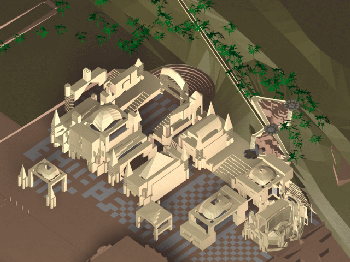
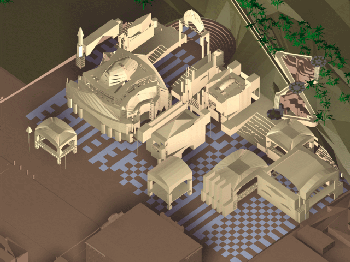

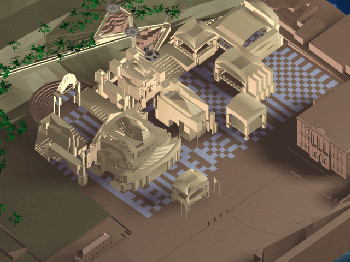

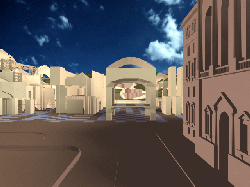
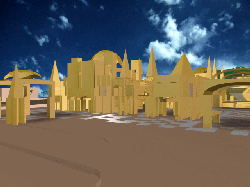
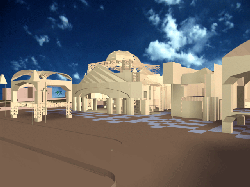

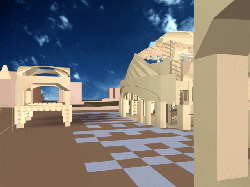


The Authors
Bibliography
Return to the first page
Mail to Prof. Celestino
Soddu
Mail to Prof. Enrica Colabella
Return to the first page











